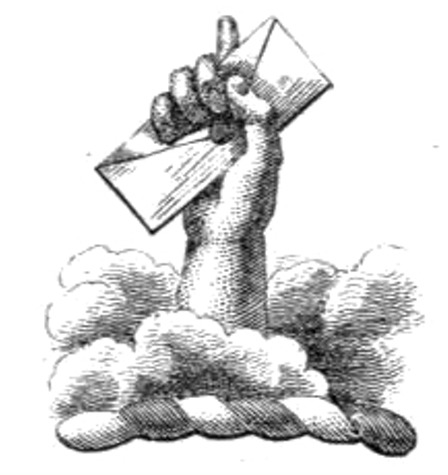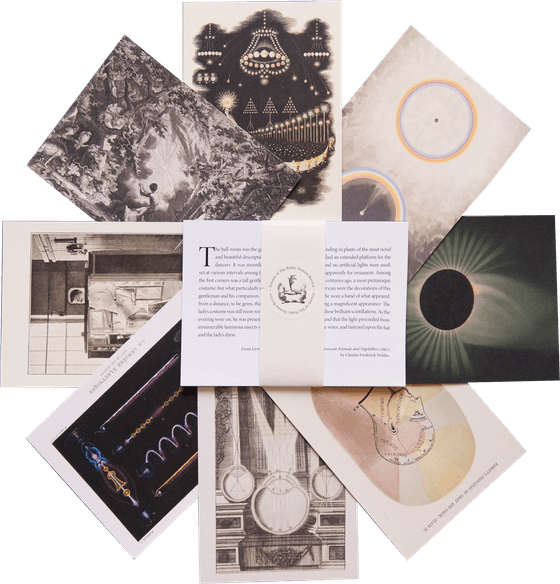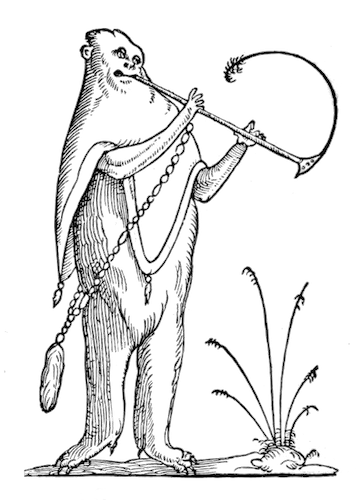
Bernard Sleigh’s Anciente Mappe of Fairyland (ca. 1920 edition)
Maps of literary worlds typically fall into one of two camps: those endorsed by an author, printed as a frontispiece or miniature, and maps born from fandom culture, retrospective plottings of journeys undertaken first in the imagination. In the former category, we find Edwin Abbot’s charts in Flatland (1884), the original cartographic rendering of Hundred Acre Wood (1926), Faulkner’s maps of Yoknapatawpha, and the anthropological diagrams by Ursula K. Le Guin for Always Coming Home (1985). Fandom maps might sound newfangled but their history is perhaps even older: consider, for example, the centuries-long tradition of trying to chart the infernal architecture of Dante’s Divine Comedy. Of all the maps created by explorers of the printed page, one in particular remains unparalleled: the English artist and teacher Bernard Sleigh’s Anciente Mappe of Fairyland, first published in 1917.
Measuring nearly six feet long, the Anciente Mappe presents a kind of “extended universe” of mythology and fairytales. Narcissus fixates on his reflection in the woods outside of Little Red Riding Hood’s house; Ulysses sails into a cove where Peter Piper and Puss in Boots romp; Lancelot climbs a mountain that also houses the Hydra and Cerberus. The map is framed by tanning mermaids, tricksy fairies, and highly ornamented borders. At its center, on the distant horizon, we find the Moone’s Sphere, circled by enchanted rainbows. Taken as a whole, Sleigh’s vision gives the impression that all human stories, all tales of magic and mystery, are piecemeal fragments from a singular, cohesive landscape.
One almost wants to live inside this map, where the disparate roots of a certain tradition of mythic imagination seems to emerge and remix. And indeed, when it was first published, it came to offer a kind of escape from the devastating closure of World War I. Yet Sleigh had first drafted his Anciente Mappe nearly a decade earlier. Like all good works of literary fandom, it emerged from a love of reading and sharing stories. “Every day after lunch, before he set off on his bicycle for the afternoon session at the Art School, he would read to the two of us”, recalled Sleigh’s daughter Barbara, a celebrated children’s author. “One wet holiday my father drew a Map of Faeryland for us. On it were marked the sites of all our best-loved fairy-stories. There is Peter Pan’s House, and the palace of La Belle Dormante and the Bridge of Roc’s Eggs, and such succinct entries as ‘Here be bogles’ and ‘Warlocks live here’. It has fascinated several generations of children.”
Sleigh’s career as an artist had one sole throughline: fairies. Some of his interest in Fairyland evidently stemmed from medical trauma. In the late 1890s, he developed an abscess in his inner ear. Doctors trepanned him, drilling a hole in his skull, and, ever after, he would see otherworldly things. “Sudden, overpowering, colour visions, came to Bernard at any time — in the street, when at work or among friends. The visions were preceded by a scent, which he described as ‘curious and very destructive.’” He would come to narrate these experiences as feeling like he was “suspended between child and man, existing on both a temporal and psychic plane.”
Originally published as a three-sheet lithograph in scroll form in 1917 (and subsequently as a reduced-size single sheet circa 1920, the version we are featuring here), the Anciente Mappe of Fairyland was later remade by the artist into a Rosebank Fabric, which led to well-paying textile commissions after his retirement from teaching in 1937. Long before that, however, he released a set of twelve woodcuts interleaved with prose and verse titled The Faery Calendar (1920), which includes a matter-of-fact preface about the world of nixies and sprites. “I believe in Faeries. It is very natural and not a bit foolish; for in these days we are quickly learning how little we know of any other world than our own.” His next work, A Faery Pageant (1924), was published not long after the Cottingley fairy hoax (Sleigh sided fully with Arthur Conan Doyle), in a limited edition of 475 copies, which sadly, like the calendar, remains undigitized. In 1926, he released his most substantial work of prose: The Gates of Horn: Being Sundry Records for the Society of Faery Fact and Fallacy. Across almost three hundred pages, Sleigh offers case studies of human encounters with Dreamland, discusses the use of mescal buttons for accessing the fairy world, which he discovered thanks to conversations with Havelock Ellis, and unequivocally answers “yes” to Peter Pan’s question, “Do you believe in faeries?” Unfortunately, due to the poor reception of this volume, his next work, Ardudwy, and an autobiography titled Memoirs of a Human Peter Pan were never published.
His most beautiful piece of prose, however, was released alongside the original 1917 Anciente Mappe as a pamphlet dedicated to his children. Titled A Guide to the Map of Fairy Land, the slim work sets down a philosophy as richly visual as his lithograph, and seeks to capture childhood’s sublime encounters with fairytales and folklore.
In the heart of every child, is hidden away a little golden key which unlocks the door of a silent, cleanswept room full of changing lights and mystic shadows. There, every child that is born into the world enters at times to gaze eagerly upon the one great window, pictured with ancient legends, and glowing with many colours: amber and scarlet, lapis blues and strange greens. . . . At one time or another of its life, every child that is born of a woman sets trembling fingers to open wide the flashing casements—to stand gazing, awed and silent, upon a sea and sky of gold and crimson, full of winged forms grey against its summer radiance.
Sleigh ends his pamphlet with a bibliography, pointing children in the direction of writers who have “travelled across the mountains and plains of Dreamland; returning to record their experiences in the world of men.” Malory’s Morte d’Arthur, One Thousand and One Nights, Yeats’ Irish Fairy and Folk Tales, Hans Christian Andersen, the Grimm brothers, and his beloved J. M. Barrie all feature here. His signoff is mournful, nostalgic — an adult gazing back into the faded memories of childhood: “And so, farewell; until that day of days when you and I may meet together there.”
An Anciente Mappe of Fairyland was originally made to be hung on the wall and if you would like to do just that, on your very own wall, you can purchase a special edition print of Sleigh’s extended universe — measuring a whopping 64 by 18 inches — from our shop.
Enjoyed this piece? We need your help to keep publishing.
The PDR is a non-profit project kept alive by reader donations – no ads, no paywalls, just the generosity of our community. It’s a really exciting model, but we need your help to keep it thriving. Visit our support page to become a Friend and receive our themed postcard packs. Or give a one-off donation. Already a supporter? A huge thank you for making all this possible.
May 28, 2025











